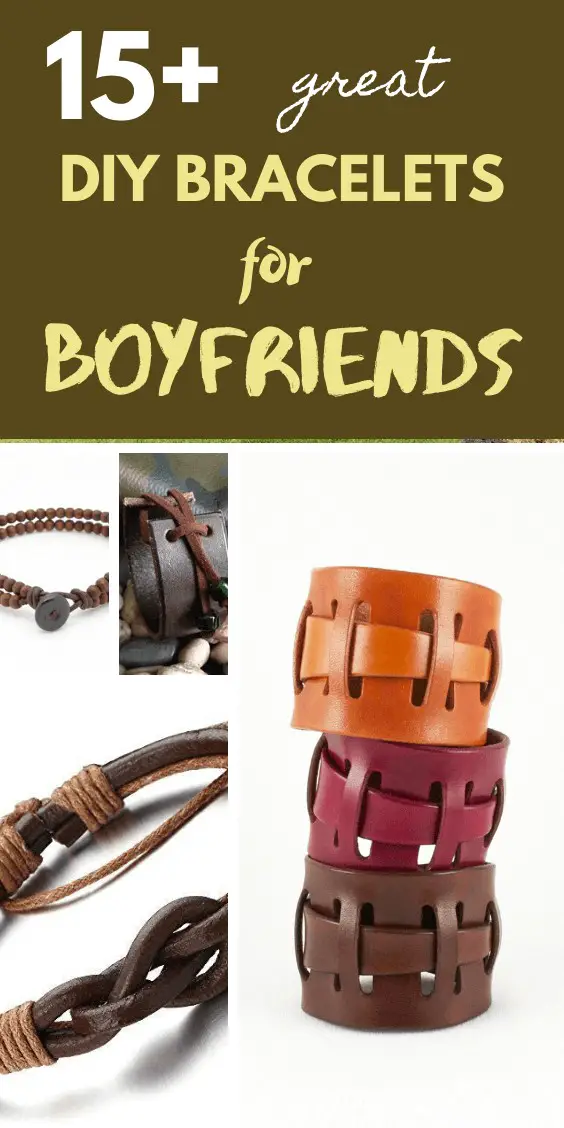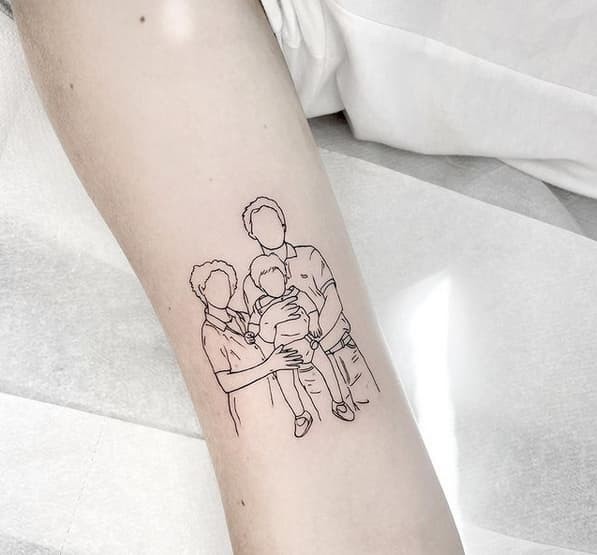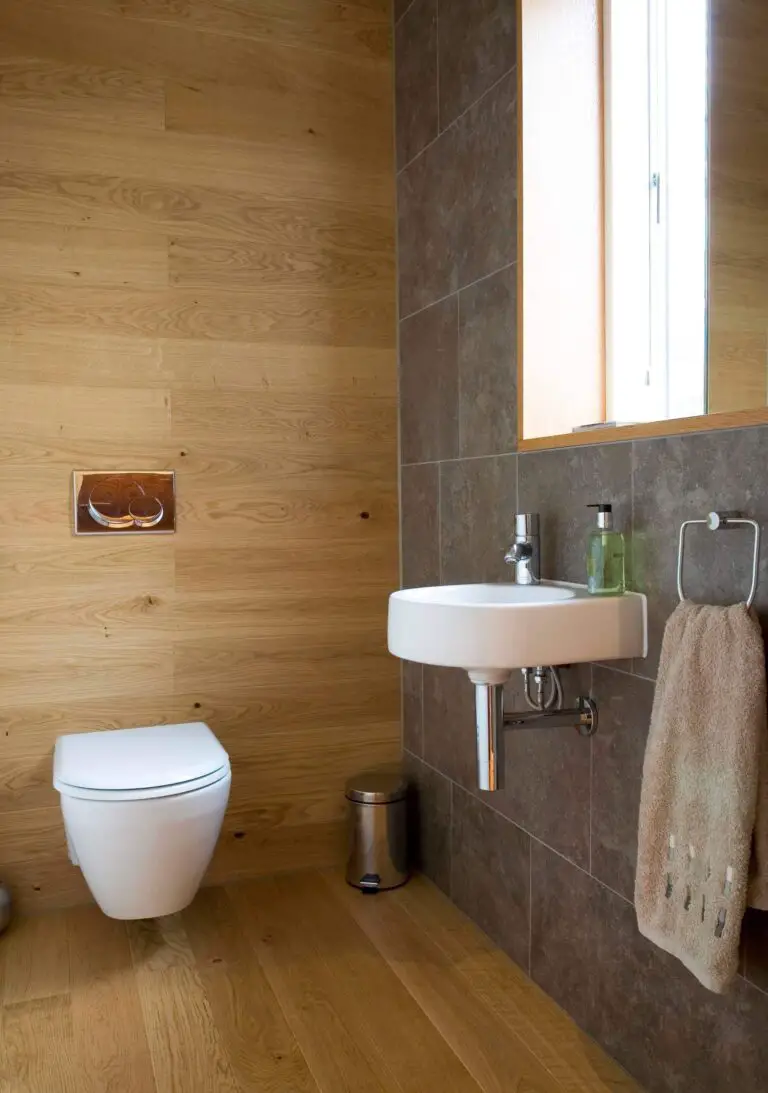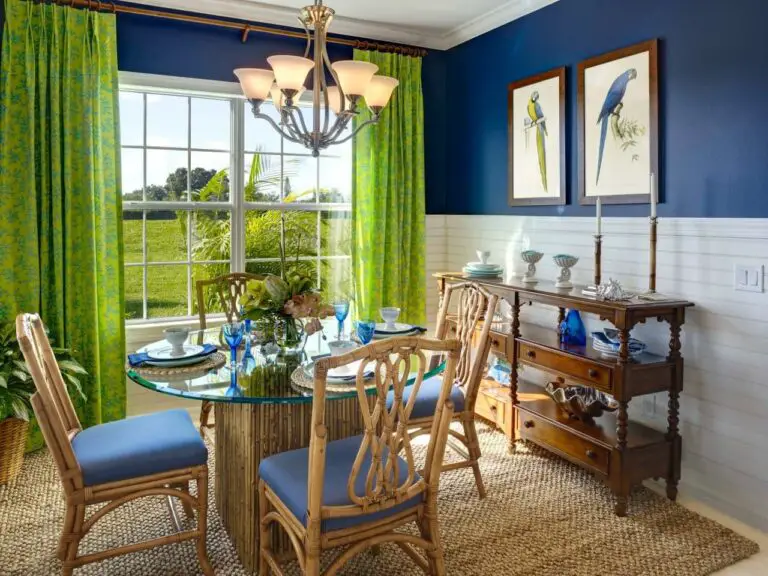28+ Best Upcycled Chair Planter Ideas To Inspire You
As you gaze at an old chair, consider the life it could have beyond being discarded. Upcycling is the perfect way to breathe new life into items that others might deem worthless. By transforming these pieces into something novel and functional, upcycled chair planters stand out as a creative and eco-friendly approach to reducing waste.
Not only does this method help our planet by minimizing the amount of rubbish sent to landfills, but it also provides a unique opportunity to create something beautiful and one-of-a-kind for your space. Old chairs, with their varied designs and structures, can be reimagined into captivating planters that add a touch of personality to any garden or home. This process not only gives a second life to what might have been wasted but also decorates our living areas originally and sustainably.
With the right chair, preparation, and creativity, you can turn an old chair into a stunning planter that brings joy and serenity to your surroundings.
Finding the Perfect Chair
Tips for Sourcing Old Chairs
When embarking on an upcycling project involving chairs, identifying the most suitable sources is crucial. Thrift stores, garage sales, and online marketplaces are prime locations for finding old chairs that can be transformed into stunning planters. Each platform has its distinct advantages: thrift stores offer a diverse range of options at affordable prices, although some may require refurbishment.
Garage sales, on the other hand, present unique finds that might need a bit more TLC, and you may even negotiate a better price. Online marketplaces provide the convenience of searching from home, allowing you to narrow down your search to local listings to avoid shipping costs. While each source has its pros and cons, they all hold potential for discovering the perfect chair for your upcycling project.
Considerations When Choosing a Chair
When choosing a chair to repurpose into a planter, consider it an investment in your project’s success rather than just a quick grab. The material, design, and condition of the chair all play crucial roles in determining its suitability. For instance, wooden or metal chairs are generally better suited for planters due to their durability and ease of modification. The chair’s design should also align with your personal style and the environment where it will be placed.
Whether you opt for a modern, rustic, or vintage aesthetic, the right design can make your planter stand out. Don’t overlook the condition of the chair either – while it may not need to be perfect, it should be sturdy enough to hold soil and plants without compromising its structural integrity. In terms of material, wood and metal chairs tend to offer a higher level of durability compared to plastic options.
While plastic chairs might seem like an affordable choice, they often lack the aesthetic appeal and robustness needed for a planter project. Instead, focus on finding a chair with a sturdy base that can withstand outdoor conditions and hold up well to the weight of soil and plants.
Preparation and Safety
As you embark on transforming your chair into a stunning planter, it’s essential to lay the groundwork with preparation and safety measures. This initial step will set the tone for a seamless upcycling experience, allowing you to focus on bringing your creative vision to life.
Cleaning and Preparing Your Chair for Upcycling
To kick-start your project, initiate a thorough cleaning of the chair to remove any dirt, dust, or grime that may have built up over time. This initial step serves both practical and aesthetic purposes – it prepares the surface for any subsequent treatments, ensuring they adhere properly, while also restoring the chair’s original appearance. If the chair features loose or peeling paint, take this opportunity to sand it down, thereby creating a smooth canvas for painting or sealing.
Safety Measures for Working with Tools and Paints
When tackling projects involving tools and paints, it’s essential to prioritize safety above all else. To minimize the risk of accidents, always don personal protective equipment (PPE) such as gloves, goggles, and masks when engaging in tasks like sanding or painting. Additionally, ensure you’re working in a well-ventilated space to prevent inhaling harmful fumes from paints or varnishes.
Furthermore, maintain a tidy workspace by keeping it organized and free of hazards that could lead to slips, trips, or falls.
Necessary Materials and Tools
To give your chair a new lease on life as a planter, you’ll need to gather some crucial materials and tools. The key elements are outlined below for most upcycling projects involving chairs. At the heart of this preparation phase is not just aesthetics – it’s also about safety and sustainability.
By taking the time to properly clean, prepare, and equip yourself with the right materials and tools, you’ll not only ensure the longevity of your chair planter but also make the crafting process more enjoyable and less prone to mishaps. While preparing your chair for its new role as a planter, don’t neglect protective measures when dealing with tools and potentially harmful substances. Your safety should always be the top priority.
Some essential materials include sandpaper for smoothing out the chair’s surface, paint or stain for giving it a fresh look, sealant to protect against the elements, and safety gear like gloves, goggles, and masks to safeguard yourself during the process. A drill or saw may also be necessary to modify the chair and create space for plants.
Design Ideas for Chair Planters
When it comes to upcycling an old chair into a planter, creativity knows no bounds. This project invites you to express yourself through design, whether you prefer timeless elegance or bold, artistic flair. The beauty of this transformation lies in its versatility – every style has a perfect match. Furthermore, the approach you take in creating a planting space can be tailored to your preferences and the unique characteristics of the chair itself.
Painting and Decorating Your Chair Planter
To give your chair planter a new lease on life, start by considering its aesthetic. You can opt for a timeless look that features neutral hues or a natural wood finish, allowing it to blend harmoniously with your outdoor space’s existing decor. Alternatively, you can go bold and artistic with bright colors or intricate patterns, transforming the chair into a statement piece in your garden.
When deciding on an approach, keep the following guidelines in mind: classic looks are best suited for traditional gardens where blending with the landscape is key, while bold, artistic expressions work well when adding a focal point or injecting some color into the space. Ultimately, the choice between these two styles will depend on your personal taste and the overall ambiance you want to create.
Adding a Planting Space
To incorporate plants into your chair, you’ll need to think creatively. A simple yet effective approach is to remove the seat entirely, allowing for direct soil planting. This method works particularly well with wooden chairs, where the seat can be easily detached and replaced with a container filled with soil. On the other hand, using pots offers a more flexible solution, as they can be placed either in the seat opening or atop the chair, depending on its design.
By integrating plants into your chair, you’ll not only add some greenery to your space but also create a unique and eye-catching feature.
Creative Touches
To further personalize your chair planter, consider incorporating unique features that not only enhance its functionality but also reflect your personal style. One innovative approach is to add wheels to the bottom of the chair, allowing for effortless repositioning around your garden or patio. This mobility feature proves particularly useful when adjusting a plant’s exposure to sunlight or bringing the chair indoors during inclement weather.
Alternatively, you can repurpose the chair back as a support system for climbing plants like ivy or clematis, transforming your chair into a stunning piece of living garden sculpture. By incorporating these design elements into your upcycled chair planter project, you’ll not only create a beautiful and functional outdoor space but also showcase your creativity and personal flair.
Whether you opt for classic simplicity or bold artistic expression, the key is to have fun with the process and take pride in crafting something truly one-of-a-kind.
Choosing Plants for Your Chair Planter
When it comes to upcycled chair planters, choosing the right plants is crucial for a project that not only looks fantastic but also flourishes. Succulents, herbs, and flowers are top contenders due to their versatility, compact size, and visual appeal. While each category has its distinct advantages, they can collectively help you achieve various aesthetics for your upcycled chair planter, from modern to whimsical.
Best Types of Plants for Chair Planters
When selecting plants for your planter, it’s essential to consider the characteristics of succulents, herbs, and flowers. To make this decision easier, let’s break down the benefits and ideal uses for each type of plant.
Succulents are perfect for busy gardeners or those living in arid climates due to their low maintenance requirements and natural ability to resist drought. They’re a great choice for anyone looking to add some greenery to their space without the hassle of frequent watering.
Herbs, on the other hand, offer a unique combination of edibility, aroma, and pollinator attraction. This makes them an excellent fit for kitchen gardens or those who want to use their plants for both practical and decorative purposes. Whether you’re looking to add some fresh herbs to your cooking routine or create a beautiful display piece, herbs are definitely worth considering.
Lastly, flowers bring color and visual interest to any space.
They can also attract wildlife, making them an excellent choice for those who want to create a focal point in their garden. With so many varieties of flowers available, you’re sure to find one that fits your style and preferences.
Considerations for Plant Selection
When selecting plants for your chair planter, it’s crucial to think about three key aspects: sunlight requirements, watering needs, and growth habits. These factors will significantly impact not only which plants are suitable for your specific environment but also how well they’ll thrive in their new home. To begin with, consider the amount of daily light exposure each plant requires. Some species love basking in full sun, while others prefer the dappled shade or complete darkness.
Make sure to match your chosen plants’ sunlight preferences with the location of your chair planter, ensuring they receive the perfect amount of light for optimal health and blooming. Next, think about the watering needs of each plant. Plants can require anywhere from minimal moisture to frequent hydration. Succulents, for instance, need less water compared to flowering perennials or herbs that demand consistent moisture.
Be sure to choose plants whose care requirements align with your ability to provide them with the necessary attention. Finally, consider the mature size and growth pattern of each plant. Some species will grow upwards, requiring support, while others spread out or trail over the sides of the planter. Select plants that will complement the size and shape of your chair planter, ensuring a harmonious and well-maintained display.
Planting and Care Tips
To create a harmonious environment where both aesthetics and botany coexist, it’s essential to go beyond simply placing plants in the chair planter. A holistic approach encompasses proper planting techniques, soil selection, fertilization, and regular care. By following these guidelines, you’ll be well on your way to nurturing healthy plant growth that complements the visual appeal of your planter.
How to Plant and Secure Plants in Your Chair Planter
When setting up your chair planter, ensure that it has proper drainage to prevent water from accumulating and harming the roots. If you’re planting directly into the chair’s former seating area, consider using landscape fabric as a liner before adding soil. This will keep everything in place while still allowing for efficient water drainage. For chairs featuring pots, select containers that fit snugly within the seat opening or sit securely on the chair to prevent any shifting or falling.
Soil and Fertilization Recommendations
When it comes to nurturing plant health, selecting the ideal soil is crucial. A well-rounded potting mix can cater to most plants’ needs, providing adequate drainage and aeration. However, for optimal results, consider using a high-quality potting mix that specifically caters to your plant’s unique requirements. On the other hand, when it comes to fertilization, a balanced slow-release fertilizer is ideal.
This type of fertilizer provides consistent nutrients to plants over time, which is particularly important for potted plants, as they can quickly deplete nutrients in their limited soil compared to those planted directly in the ground.
Watering Tips for Maintaining Healthy Plants
When it comes to watering, it’s essential to consider the unique needs of each plant. A general guideline is to water when the top inch of soil feels dry to the touch. However, be mindful not to overwater, as this can lead to root rot and other issues. Factors like temperature and environmental conditions can significantly impact watering needs. In hot weather, plants may require more frequent hydration, particularly if they’re exposed to direct sunlight or strong winds.
It’s crucial to strike a balance between keeping your plants well-hydrated and preventing overwatering.
Seasonal Care and Protection Advice
Caring for plants in upcycled chair planters demands attention to their needs across various seasons. While they may thrive with proper setup, soil management, and regular watering during most times of the year, extreme weather conditions can pose a threat. In scorching summers, ensure shade cover during peak sun hours to prevent scorching, and adjust your watering schedule accordingly.
Conversely, in cold winters, consider relocating the planter indoors or shielding it with burlap or frost cloth to safeguard against frost damage. Additionally, monitor for pests and diseases, making adjustments to your care routine as needed. By taking these seasonal considerations into account, you can maintain a thriving plant display that adds beauty and charm to your outdoor space.
Additional Upcycling Ideas
While transforming an old chair into a planter is a great starting point, the possibilities don’t stop there. Many other furniture items can be creatively repurposed into planters, allowing you to add one-of-a-kind touches to your garden or home. From repurposing vintage dressers as herb gardens to turning wooden crates into succulent containers, the options are truly endless.
By embracing upcycling projects and thinking outside the box, you can breathe new life into old furniture and create functional works of art that bring joy and beauty to any space.
Furniture Items That Can Be Upcycled into Planters
Unleash your creativity by transforming everyday furniture into unique planters. From dressers to bookshelves, and even old desks, the possibilities are endless. Each piece of furniture offers a distinct canvas for modification and decoration, allowing you to create one-of-a-kind displays that bring life and greenery into any space. Imagine opening drawers at varying levels on a dresser, creating a tiered plant display that adds depth and visual interest.
Or picture a bookshelf with each shelf holding pots or custom boxes, perfect for creating decorative indoor or patio arrangements. For those who dare to be bold, consider removing the drawers from an old desk or cutting out the top to create a statement piece in your garden or yard. With a little imagination and some creative upcycling, you can turn any piece of furniture into a thriving planter that will delight the senses.
Encourage Creativity and Personal Expression
As you embark on an upcycling journey, the possibilities are endless, limited only by your imagination and creativity. Unlike traditional gardening projects, there’s no one-size-fits-all approach when it comes to transforming furniture into planters – instead, you get to infuse each piece with your unique personality.
Don’t be afraid to think outside the box (or planter) as you experiment with colors, finishes, and planting arrangements to create truly bespoke pieces that harmonize with your space and your green thumb.
Before and After DIY Chair Planter
Flower planter chair
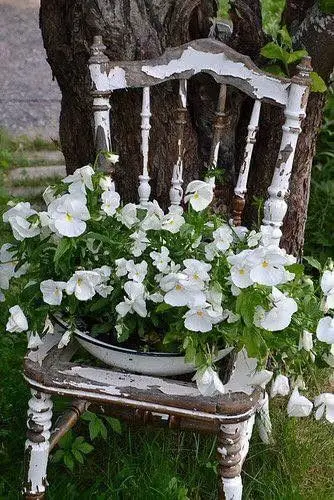
Recycled flower chair
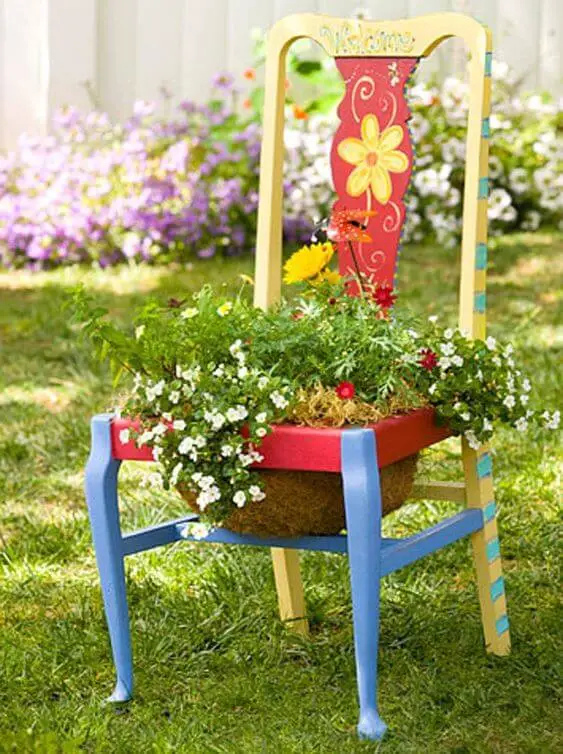
Chippy Chair with boston fern
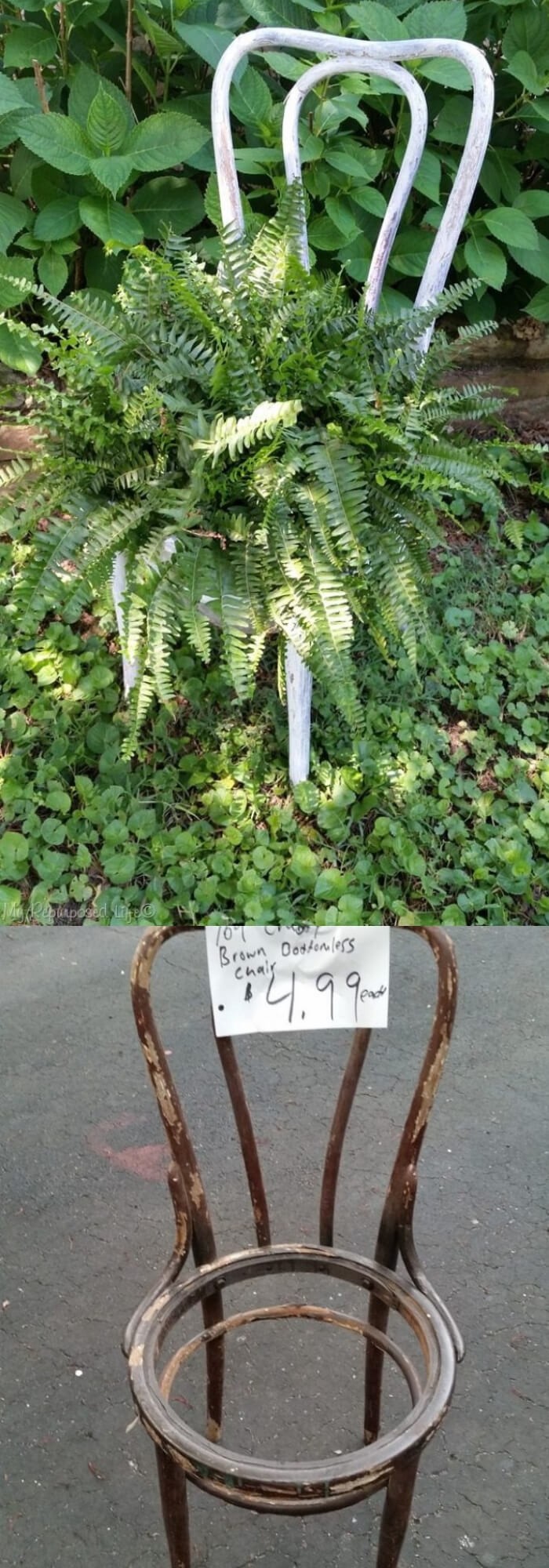
Painted Sunshine Chair
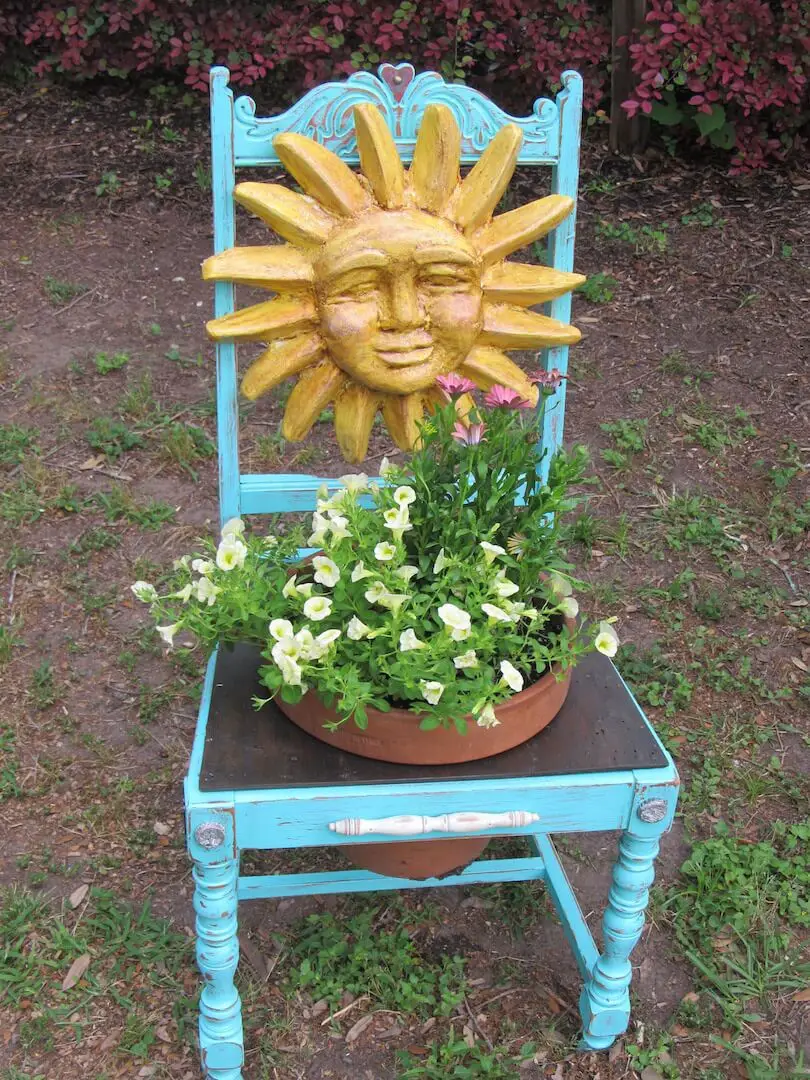
Ladderback chair
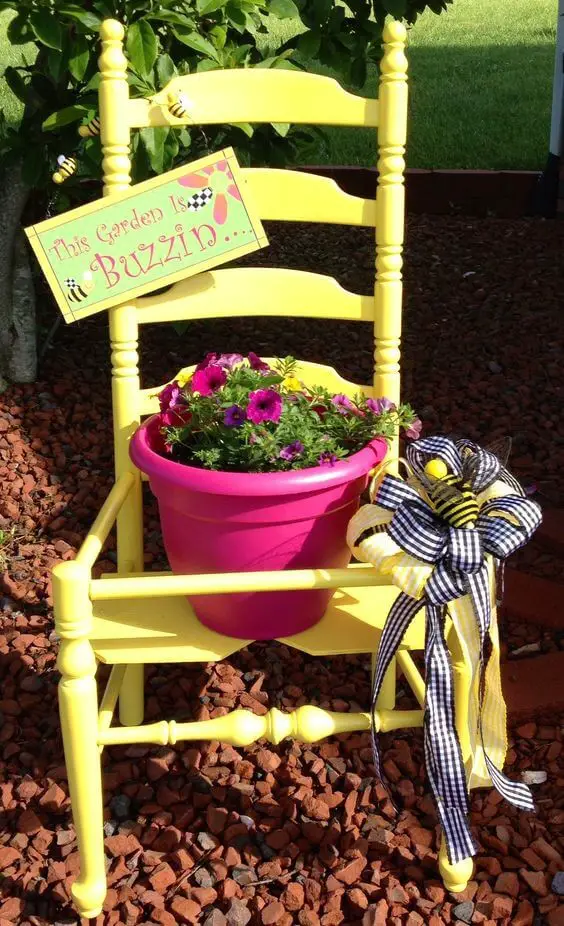
Drawer planter
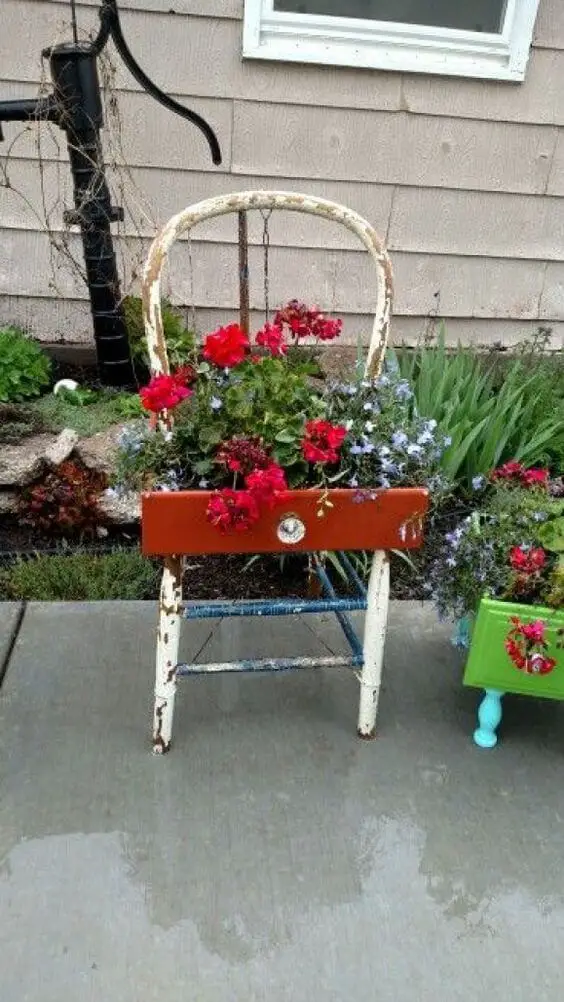
Ice cream chair planter
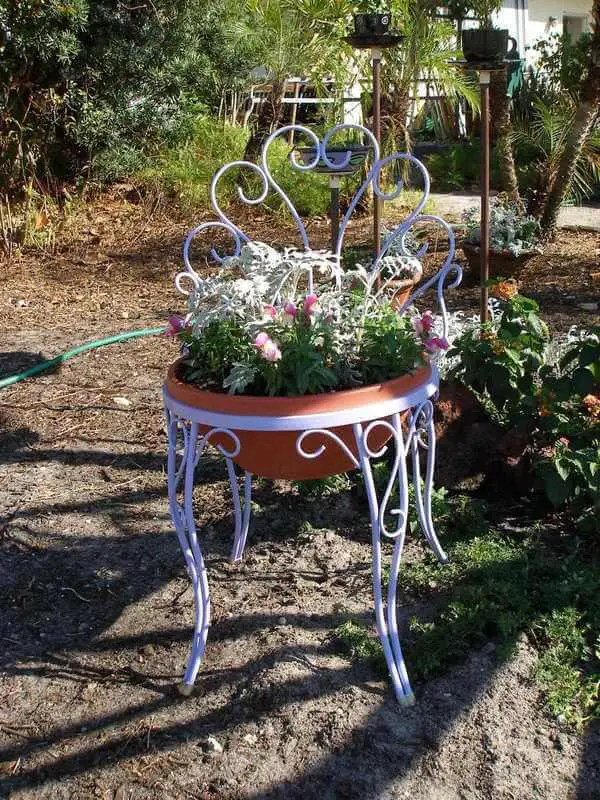
Rocking Chair Flower
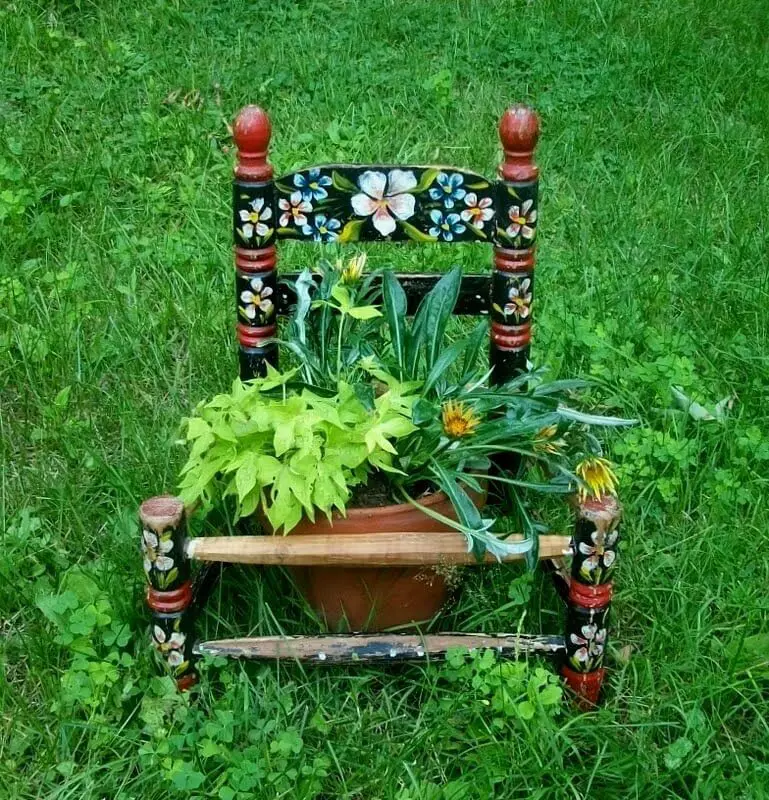
Pink chair planter
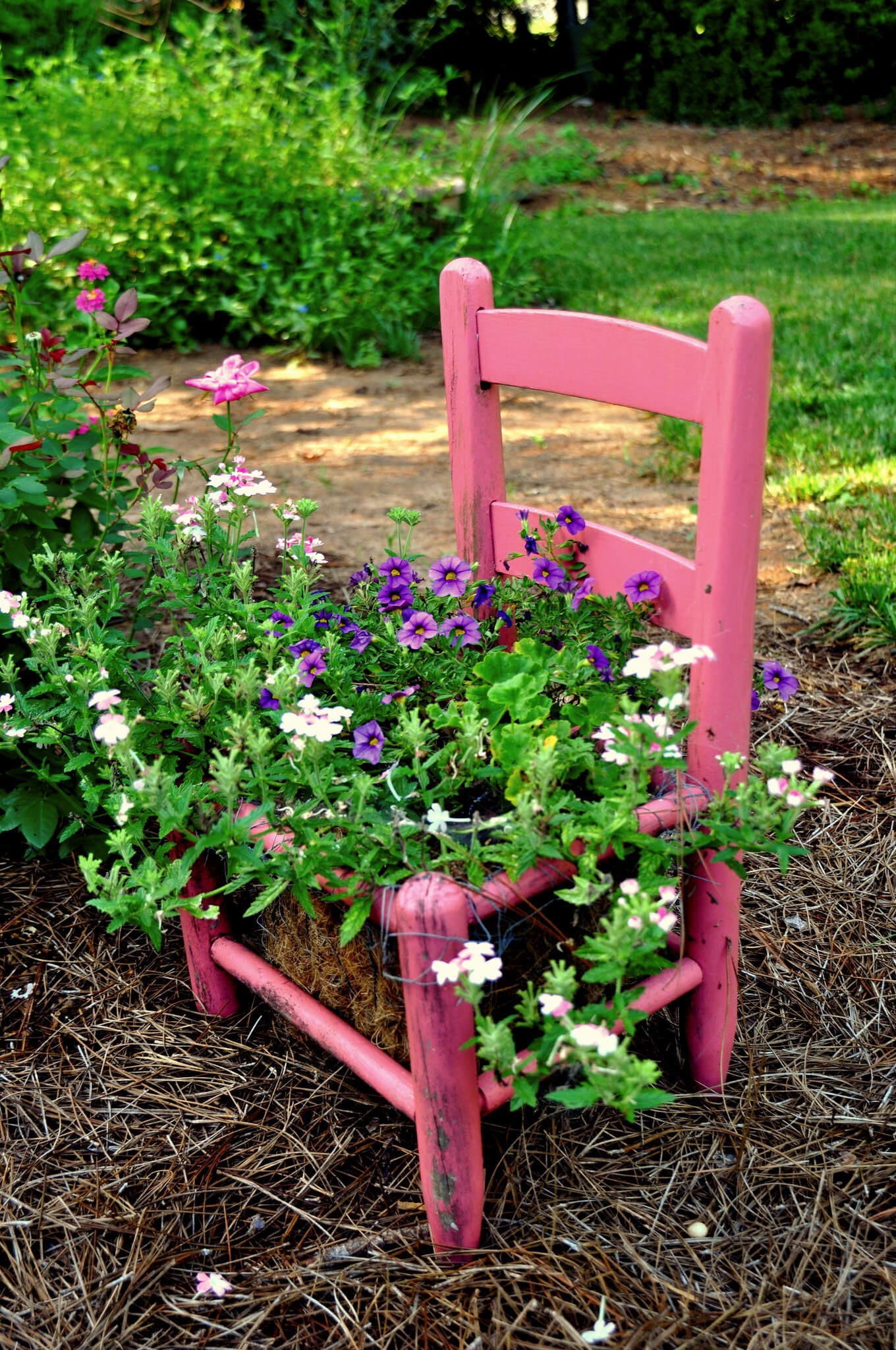
Succulent Chair planter
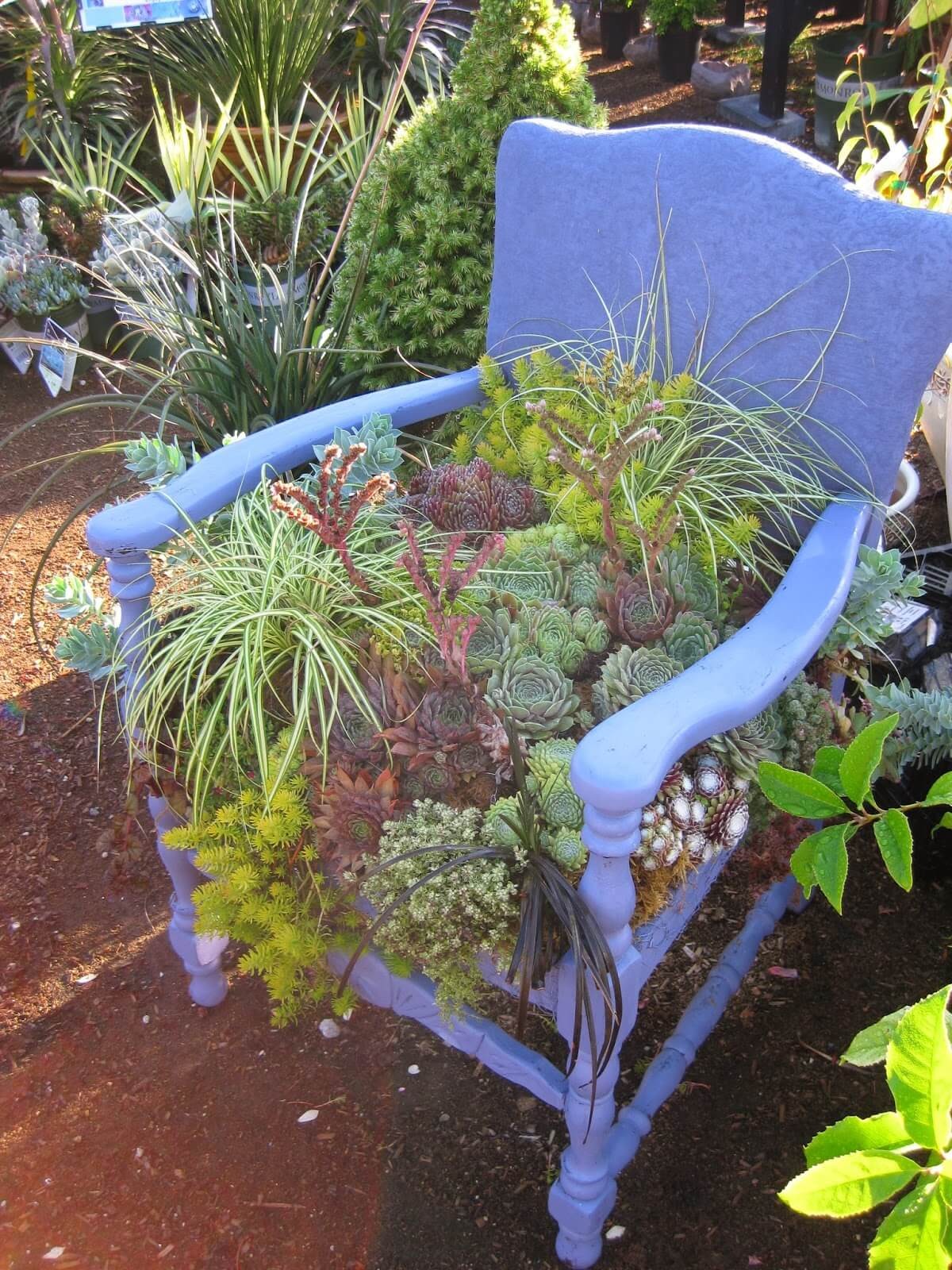
Garden of Music
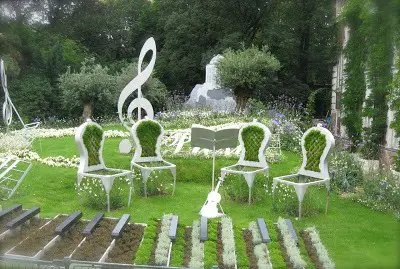
Turn a wooden chair into a planter
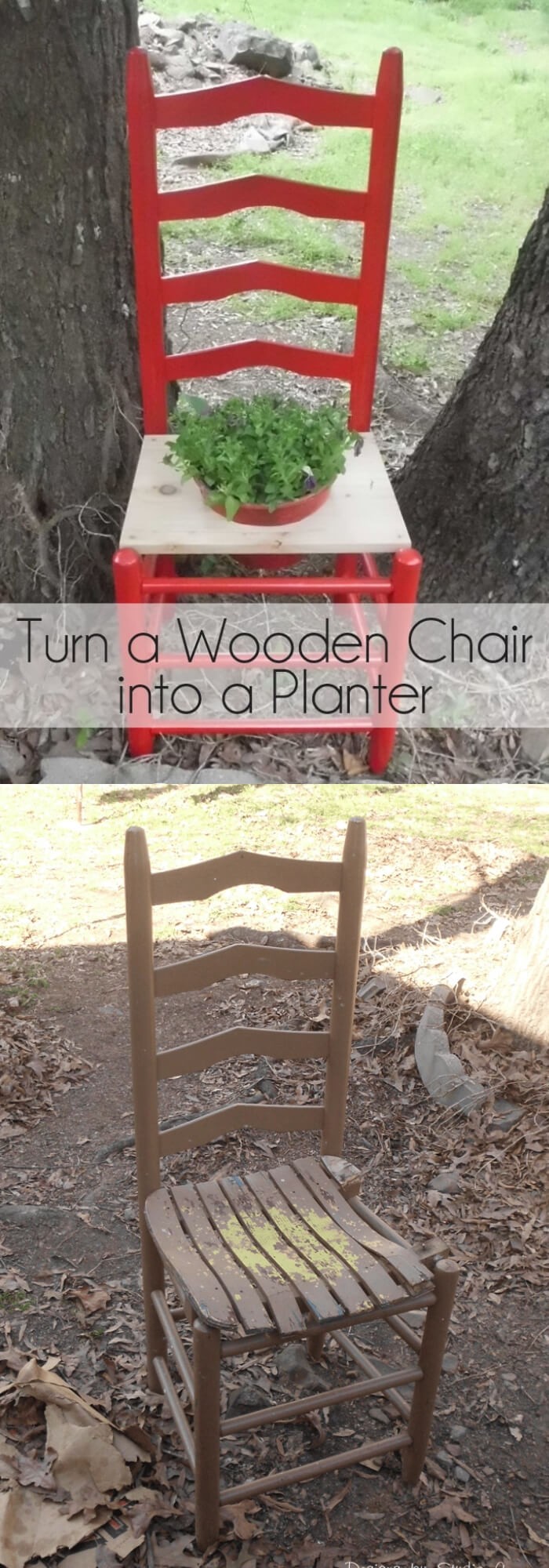
French Garden Chair
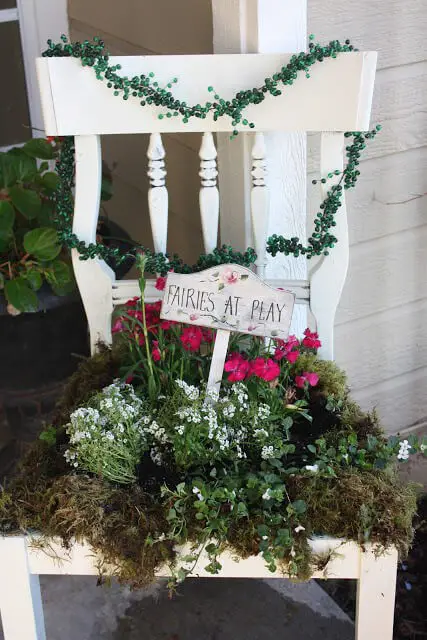
Vintage Chair Planter
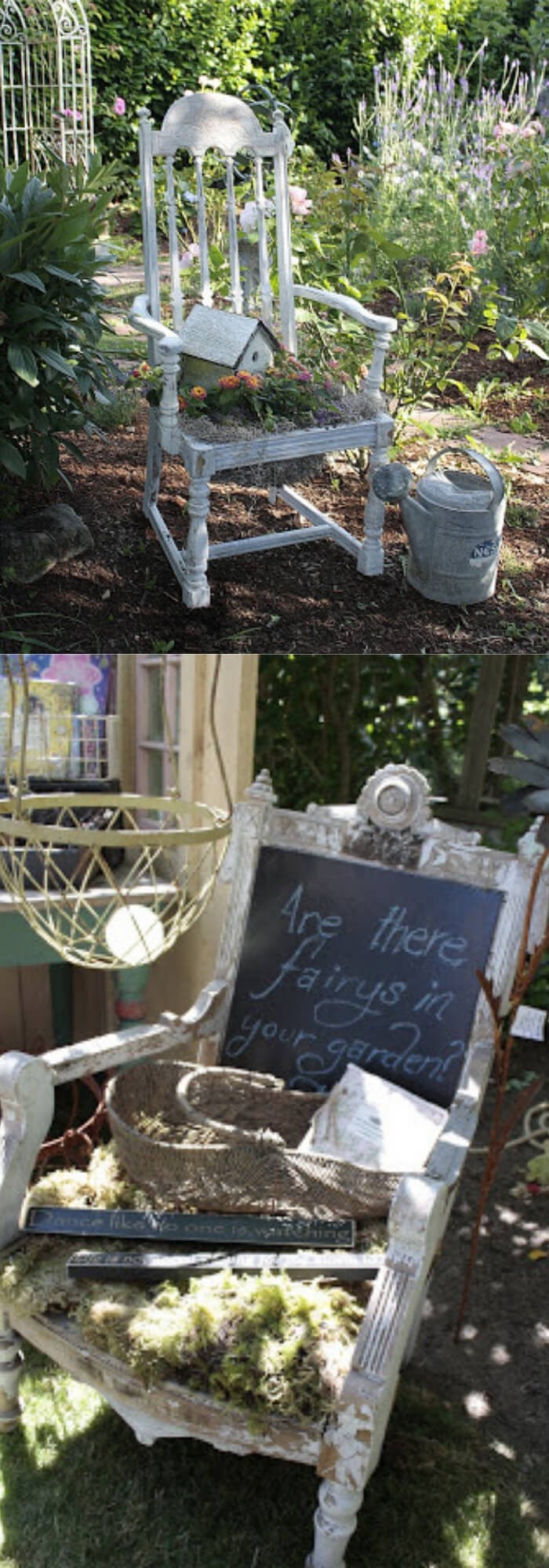
Mason Jars Chair Planter
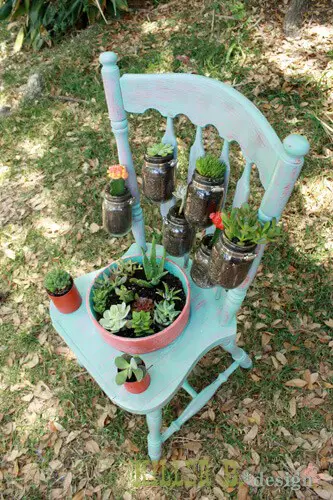
Hanging Chair Planter
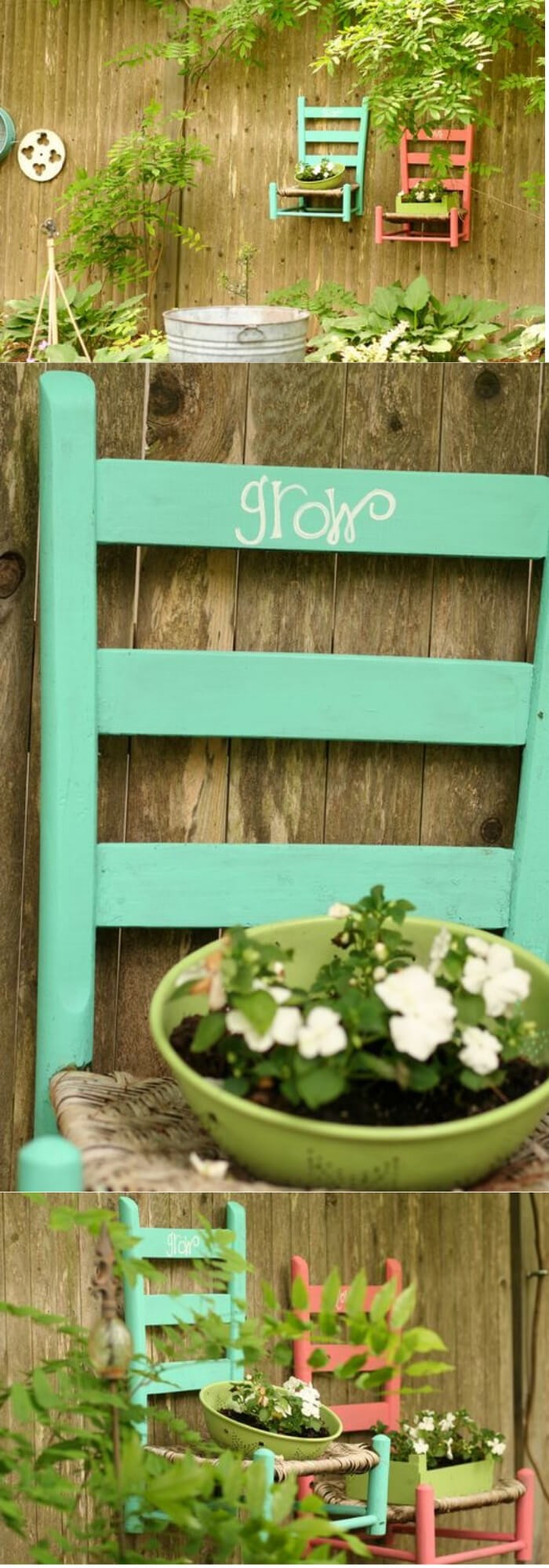
Piece of sunshine
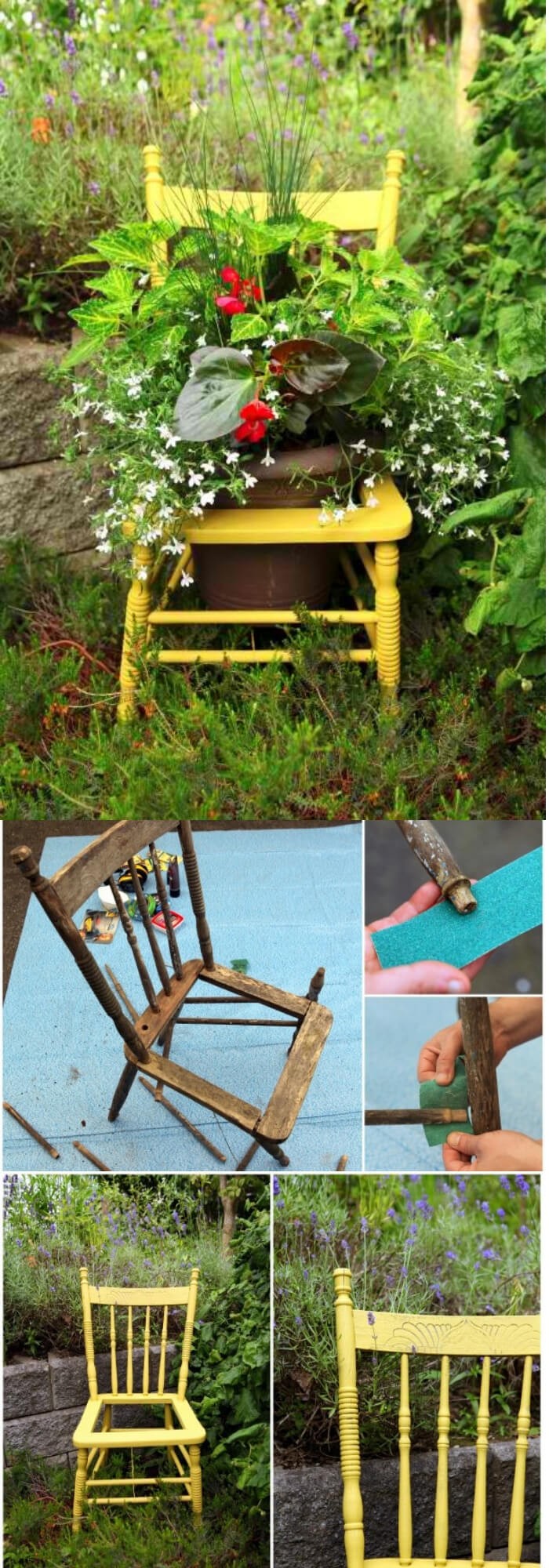
Vintage Chair Planter
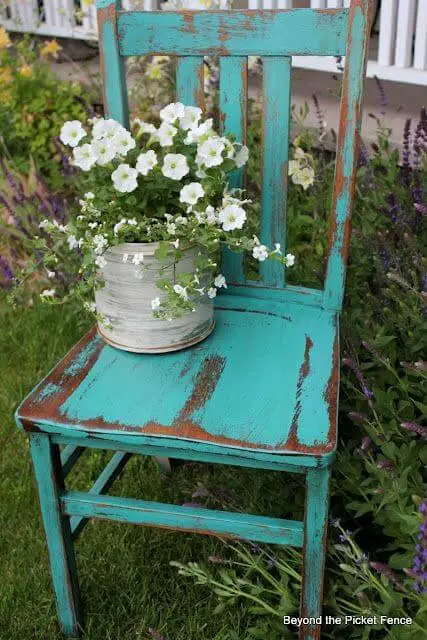
Vintage Sign on a Reclaimed Chair
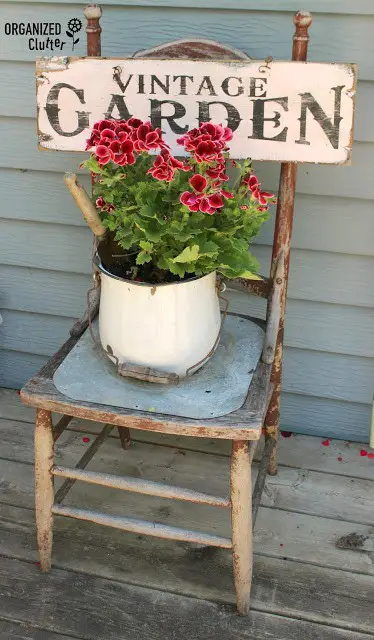
Rust in peace
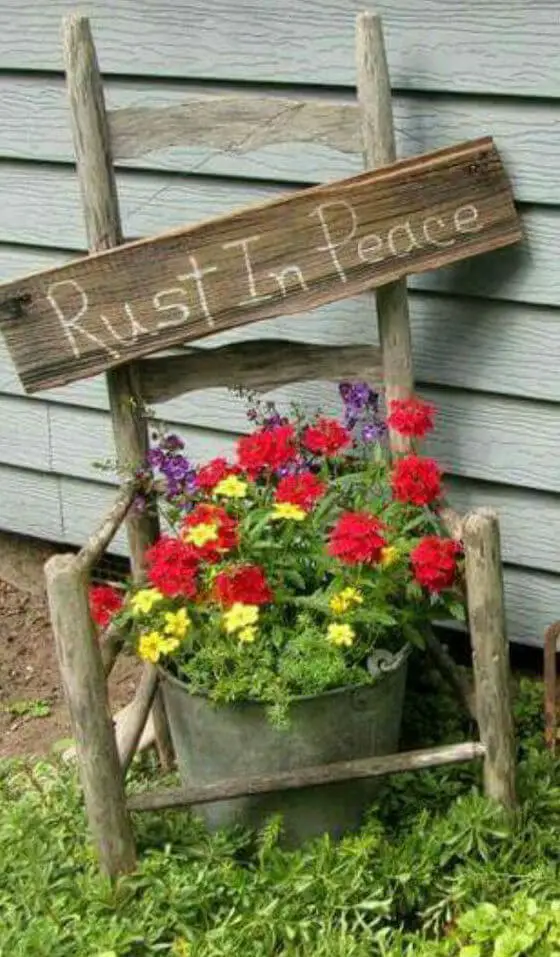
DIY moss covered chair
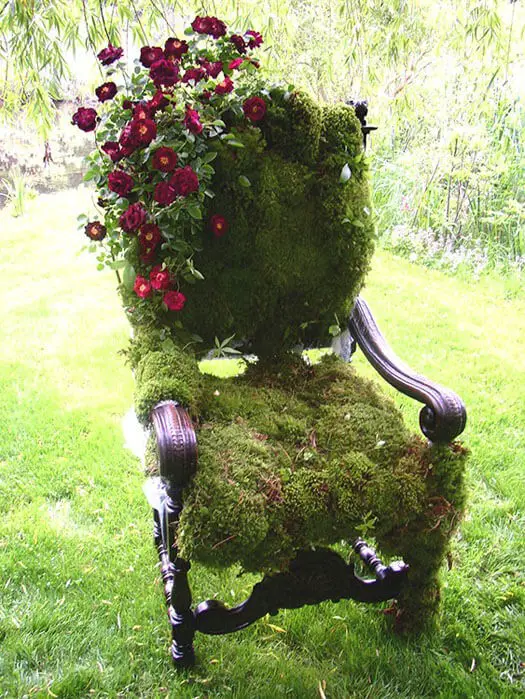
Farmhouse Red Chair Planter
The rocking chair planter (before and after)
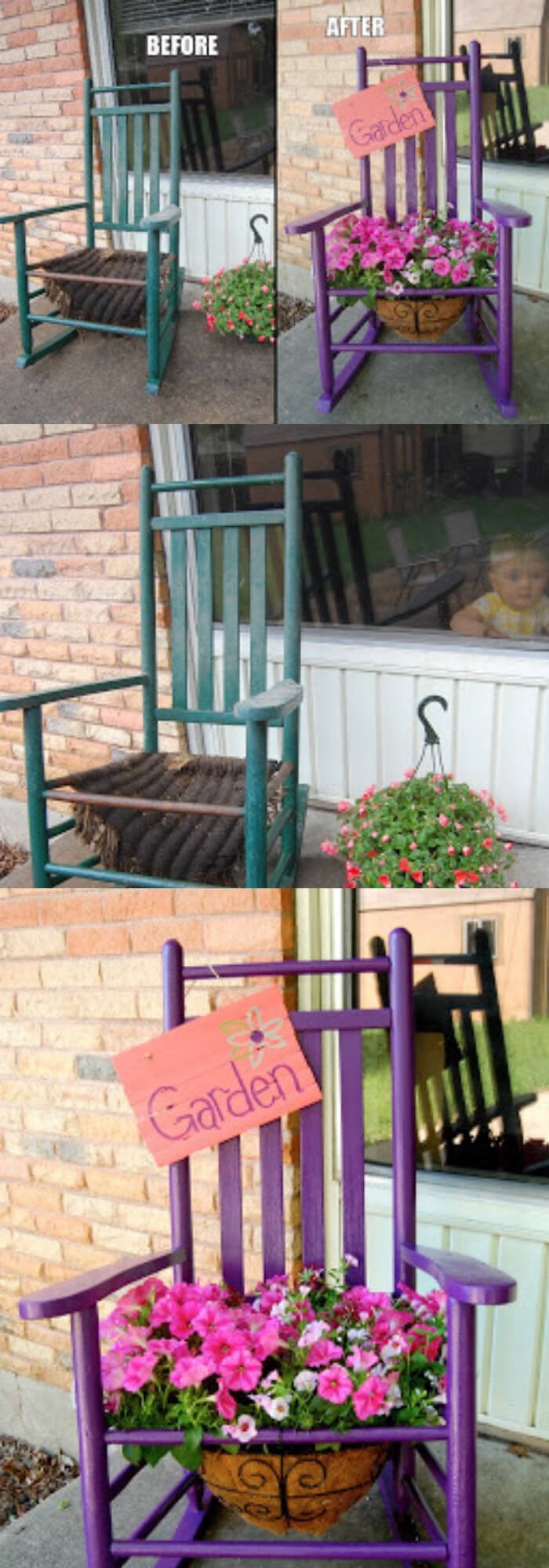
Old tin watering can with cane chair
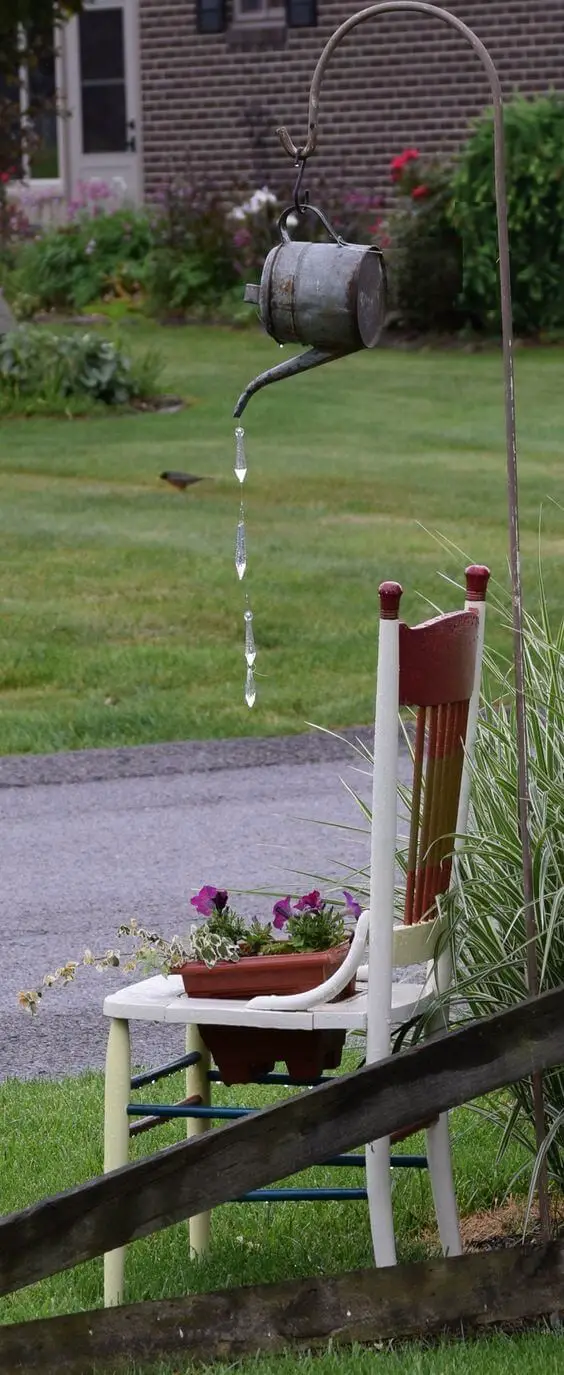
Flower pot chair
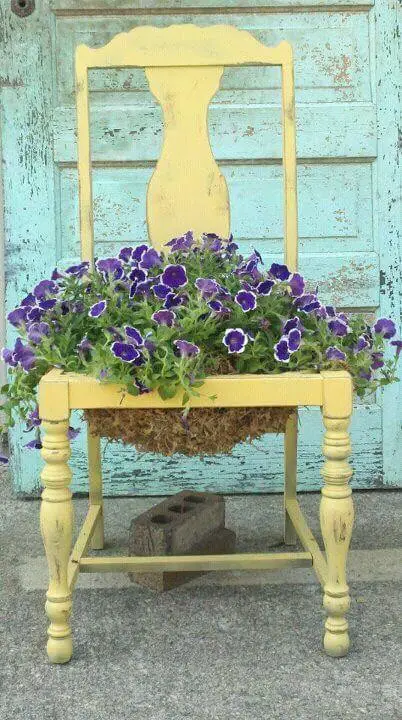
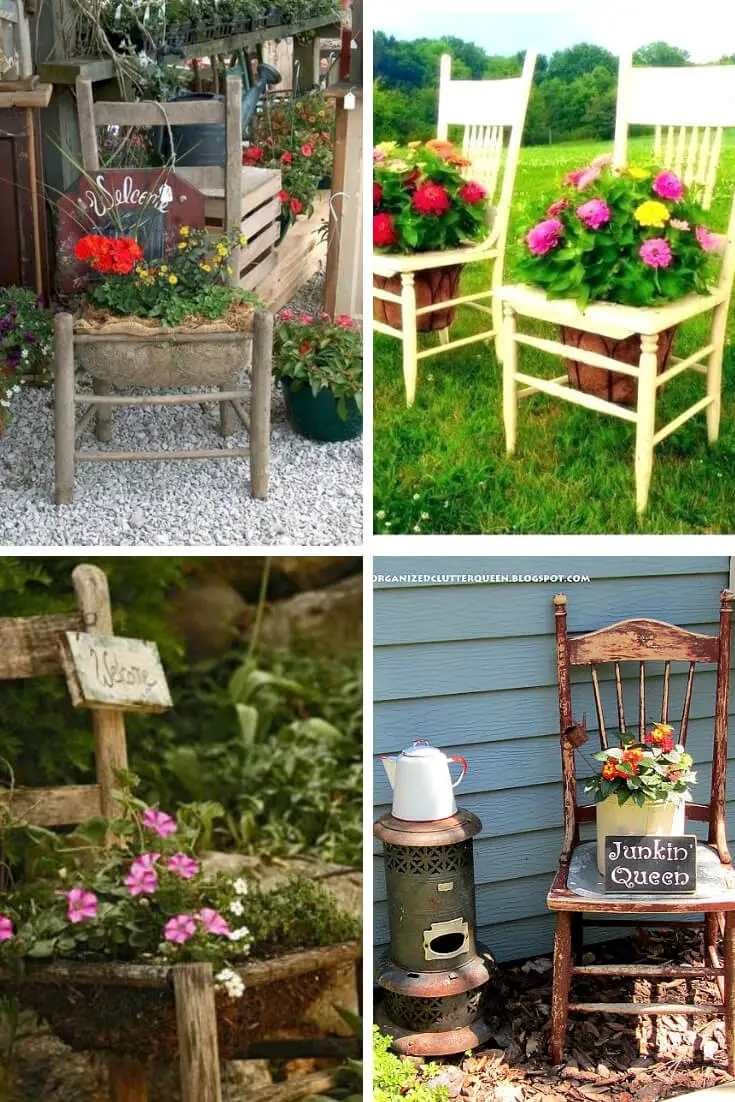
Placement Ideas for Chair Planters in the Garden
When incorporating a chair planter into your garden, the right positioning can significantly elevate its visual impact. Whether seeking harmonious integration with your existing landscape, creating a striking focal point, or finding a balance between aesthetics and practicality, strategic placement is crucial. This thoughtful consideration can transform your chair planter from a mere decorative element to a standout feature that brings your outdoor space to life.
Suggestions for Integrating Chair Planters into Garden Design
When incorporating a chair planter into your outdoor space, consider the surrounding environment to ensure a harmonious blend. Start by placing it among plants that share similar water and sunlight requirements, streamlining maintenance and care. Additionally, aligning the planter’s aesthetic with your garden’s theme can create a seamless visual cohesion.
For example, a vintage-inspired chair planter could thrive in a cozy cottage-style garden, while a sleek, modern design might elevate a contemporary outdoor space, fostering a sense of continuity between the two.
Using Chair Planters to Create Focal Points
A chair planter can be a striking addition to any garden, serving as a visual anchor that draws the eye and invites exploration. Placed strategically at the center of a garden bed or along a winding path, it can create a captivating focal point that adds depth and interest. The real magic happens when you select plants with bold colors or intriguing textures to populate your chair planter.
These unique elements amplify its visual appeal, transforming it into a showstopping feature that elevates the overall aesthetic of your outdoor space.
Balancing Aesthetics and Functionality in Garden Spaces
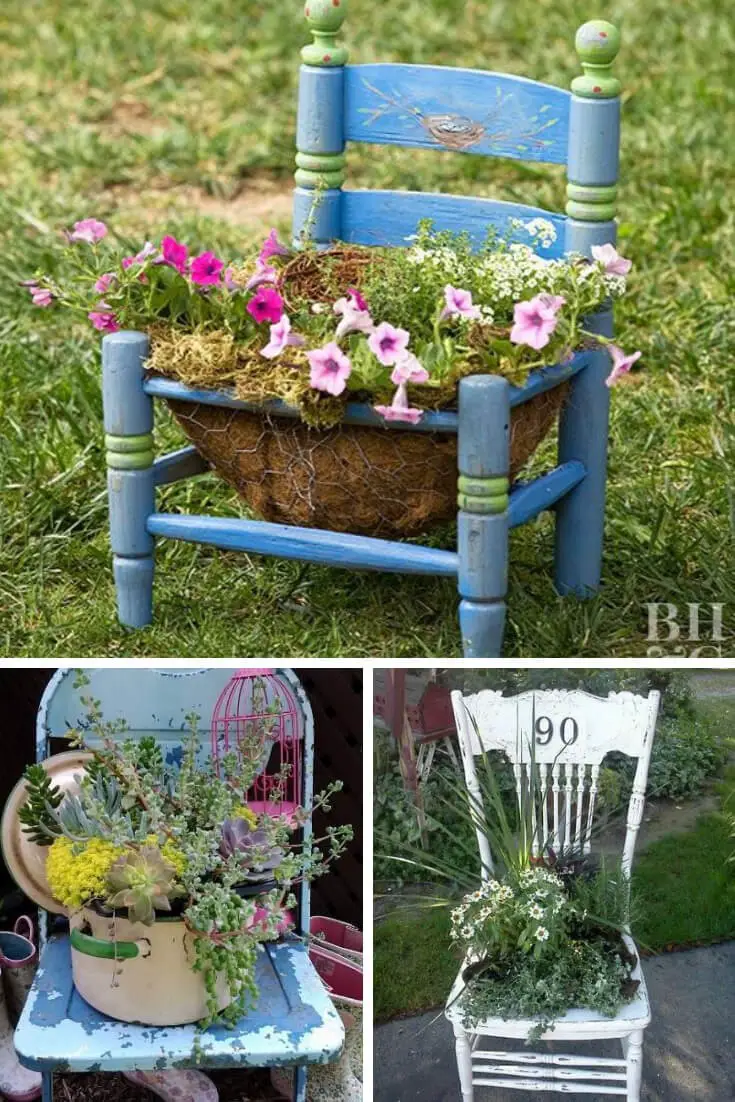
When designing your chair planter’s placement, strike a balance between aesthetics and functionality. Consider positioning it in an area that allows for effortless watering and maintenance, ensuring the planter remains a seamless part of your garden’s design. Furthermore, think about the plant’s needs: providing a sunny spot for sun-loving plants or a shaded area for those that prefer less direct light.
By doing so, you’ll not only create a visually appealing arrangement but also foster healthy plant growth. This harmonious balance will turn your chair planter into a functional and beautiful addition to your outdoor space.
Conclusion
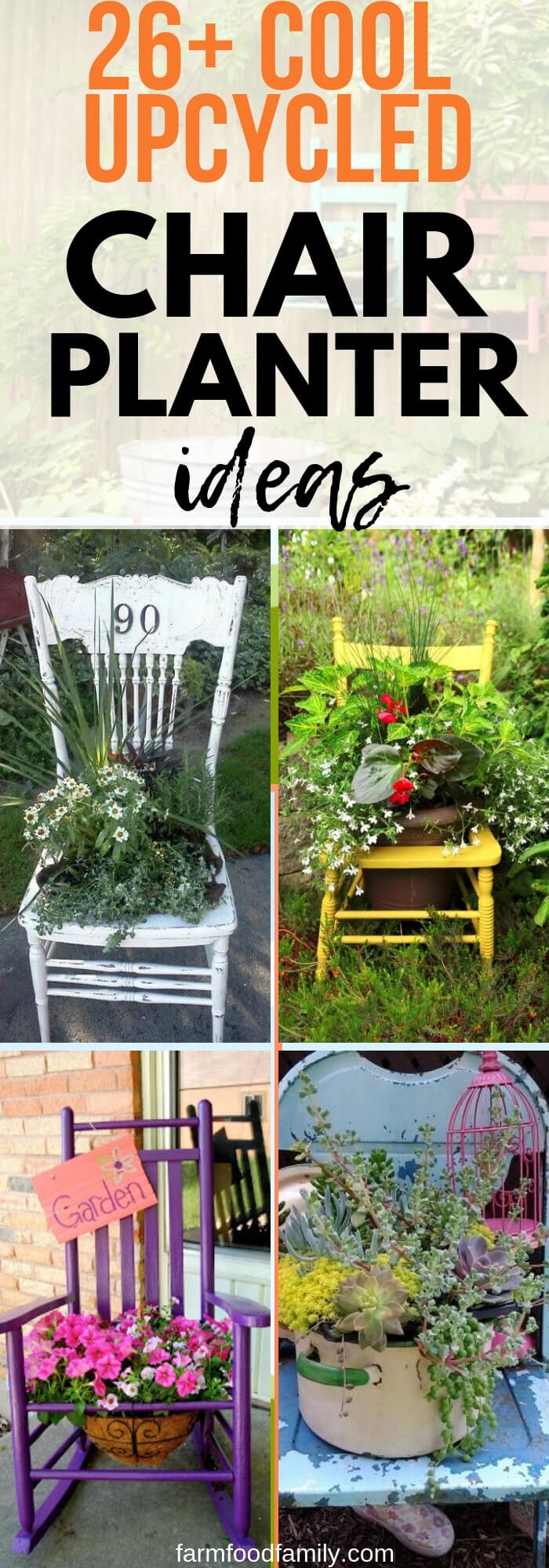
The art of upcycled chair planters converges sustainable living with creative expression. By revamping discarded chairs, we not only reduce waste but also infuse our gardens and interiors with one-of-a-kind personality. This innovative approach to decorating inspires a more eco-friendly outlook, highlighting the value in repurposing what we already possess.
As we explore the possibilities of upcycling, whether it’s transforming a chair or a dresser, we’re reminded that even the most mundane objects can be reborn into something extraordinary. We encourage you to embark on your own upcycling adventure, experimenting with designs and sharing your creations with others. Not only does this foster a culture of creativity and sustainability, but it also forges connections among like-minded individuals.
As you continue on your journey, remember that each project is a testament to the power of transformation, contributing to a collective movement towards environmental stewardship and beauty.
FAQs: Upcycled Chair Planter Ideas
What types of chairs work best for upcycling into planters?
To give new life to an old chair, look for one made from durable materials like wood or metal. These types of chairs are not only more resilient but also easier to modify into a planter. Opt for pieces that have character, whether it’s due to wear and tear or unique design elements. While a little bit of imperfection can add charm to your planter, make sure the chair is still sturdy enough to support the weight of soil and plants.
How do I ensure proper drainage for my chair planter?
To maintain optimal plant health and prevent waterlogging, effective drainage is essential. When installing plants directly into a chair seat, be sure to create holes in the bottom to facilitate water escape. Alternatively, opt for pots featuring built-in drainage holes or take the initiative to drill your own. Furthermore, incorporating a layer of gravel at the base of the soil or pot can significantly enhance drainage and promote healthy plant growth.
Can I leave my upcycled chair planter outdoors year-round?
When it comes to deciding whether to place your planter outside or inside, several factors come into play. The type of chair material and the climate you’re in are crucial considerations. Wooden and metal chairs can typically handle outdoor conditions if properly sealed and treated, but extreme weather events like heavy rain, snow, or intense sunlight can still cause damage over time.
To mitigate this risk, consider bringing your planter indoors or under cover during harsh weather periods, or apply protective coatings to help extend its lifespan when placed outdoors.
What are some creative ways to decorate my chair planter?
Imagine elevating your planter game by experimenting with bold and vibrant colors or unique patterns on your chair. Alternatively, opt for a more understated approach with stains and varnishes that bring out the natural beauty of the material. To further enhance the visual appeal, consider incorporating decorative elements such as mosaic tiles, plush fabric cushions (perfect for adding a pop of color to potted plants), or even mini shelves for showcasing additional greenery.
And why not get creative with the chair back itself? Transform it into a trellis by training climbing plants to grow up and around it, adding an extra layer of lush foliage to your overall design.
Where should I place my upcycled chair planter for the best effect?
When choosing the perfect spot for your chair planter, consider both the aesthetic appeal and practical functionality. This versatile piece of furniture can become a stunning centerpiece in your garden, patio, or even indoors if you have sufficient natural light. Prioritize placement that harmonizes with your existing decor while also providing plants with their necessary sunlight. Additionally, think about accessibility for watering and caring for your plants.
Avoid locations that are too challenging to reach, as this may hinder maintenance and upkeep.

